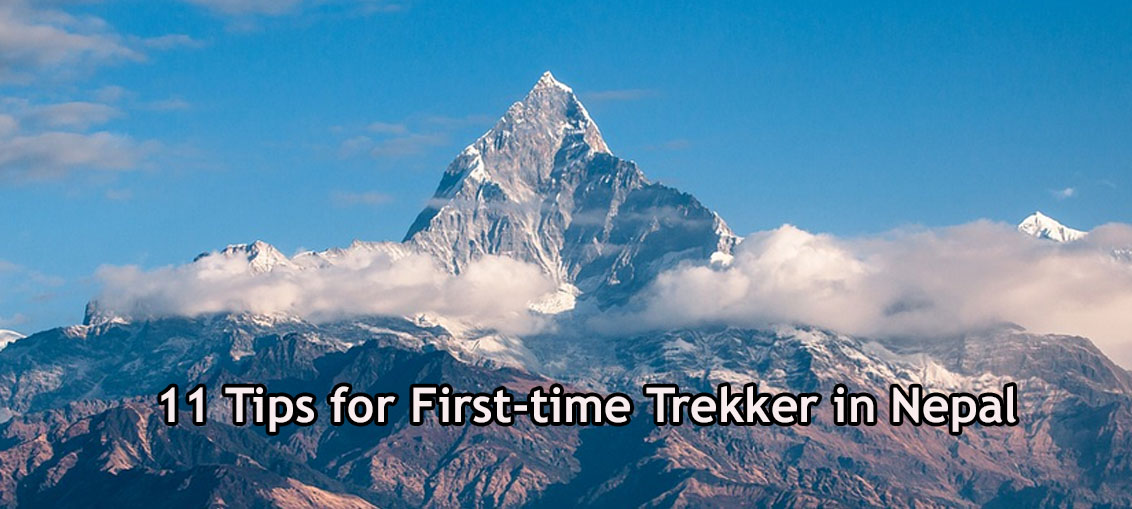11 Tips for First-time Trekker in Nepal
Completing a trek in the tallest mountain in the world enough motivation for any avid hiker. You don’t have to be a seasoned mountaineer or an experienced world traveler. You just have to be in good shape, love to walk, have a sense of adventure and an open mind to different cultures, you can make this dream come true. Here are some of the tips going on your first trekking trip in Nepal.
- Start off Easy.
16 days of trekking to Everest Base Camp may sound unusual, but if this is your first time traveling to Nepal or taking on an extended hiking trip, it is best to start off easy. It might be recommended that hikers should choose a shorter trek which starts in the lower altitude Annapurna region. You’ll experience some challenging days, as there are long hours of uphill and downhill walking. But you’ll be rewarded by seeing the stunning farming villages and beautiful mountain vistas.
- Use a tour company or go independent?
You can choose between going on a trek alone or with a guide. Most independent hikers opt to join a tour company, as save you time, frustration, and a peace of mind that all your plans and arrangement will be made as expected. Most tour operators provide an English-speaking local guide and porter support team. You’ll meet solo hikers on the trail that are trekking on their own. The good thing about joining a tour with an experienced guide is that you will not only gain new friends but they will facilitate logistics and bring you to the secret areas that are less visited by hikers. In some cases, there are guides who live in the area that you’re trekking to and knows the villagers, who are likely to invite you to their homes for a cup of coffee or tea.
Aside from the trekking guide, you will also be accompanied by a porter to carry all your belongings except for you day pack which you will carry. It might be uncomfortable, but you’ll get used to this traditional way of traveling and the use of porters is a great way to hire local people and give them a good income. So before leaving on the trek, you will be given a duffle bag where you can put all your belongings for the trek. The porter will carry it to your next lodge or camp. These porters will often walk ahead of you as they already know the route and they’re much quicker. Part of the job of these porters is to arrive first at your lodge and make sure to get you the best available room.
- Trekking Lodges
You can choose which type of accommodation you’d like to rent, ranges from the very basic teahouses to comfortable family owned lodges, to corporate-owned luxury lodges. Most trekking routes in Langtang, Annapurna, and Everest region, lodge trekking is available. However, don’t expect Western-standard rooms, amenities, or bathrooms. A standard family-run lodge will give you a comfortable room, healthy food options and hot food choices, a great place to meet fellow trekkers from the different parts of the world, and of course amazing views. Most rooms include a wooden bed with a new mattress, lamp, and small table. It can get cold at night on a late fall trek, so a sleeping bag with a provided heavy blanket will keep you cozy and warm.
The mornings can be cold, so keep your clothes you want to wear the next morning inside your sleeping bag.
It is advisable to keep inside the sleeping bag the clothes that you’re going to wear the next morning, as mornings can be cold. This is the best way to avoid putting on freezing clothes in the morning.
- Listen to your body
Not all of us are trained to hike multiple days in a row, so there are days or point that the hike will feel tough, regardless of your fitness level. Good thing is that your guide will be keeping a close eye on you and will be there by your side to help you. He’ll surely encourage you to stay hydrated and drink, and also follow you on your comfortable pace. You will stop at a lodge every day for lunch, but it is advisable also to bring extra goodies in your day pack to keep energized.
- Don’t buy, Rent.
Pokhara and Kathmandu have plenty of gear shops offering every bit of gear and clothing you need for your trek. Puffy jackets, eco-friendly mattresses, hiking poles, and sleeping bags, you’ll surely find these items at cheap rental prices. Renting allows you to simply return items that you need for that specific trek and might not use again, so you can save space in your backpack after your trek is over.
- Altitude Education.
The Himalaya is an undoubtedly beautiful range of mountains, but it’s important not to get too amazed about your surroundings and to always be mindful of the proper high-altitude safety. You need to research the effects of high altitude and the dangers it can bring prior to arriving in Nepal will educate you before you are overwhelmed with the excitement and the culture shock of your trip to this country.
You might have trouble adjusting to the thinner air, just like everyone, at some point on their high-altitude adventures. It’s difficult to predict how your body will react on this kind of altitude, that’s why you really need to research first about it. The only way to truly adjust well is by taking your time; do not force yourself if your body is telling you to rest.
- Things run on Nepali time.
Locals of Nepal are extremely kind, calm, and giving, and their attitude towards the pace of everyday life is slow. This means that it’s easier to interact with these charming people, but you’ll need to be patient if unexpected things happened or do not run as smoothly as you expected.
- A little understanding goes a long way.
This beautiful country is filled with followers of different religions; the main two big followers are Hinduism and Buddhism. These great belief systems are full of colorful symbolism that is widespread throughout the country.
While you’ll learn more about these Nepal’s religious culture during your visit, a little research about Nepal will serve you well before arriving. That way, when you are appreciating the marvelous architecture and statues, monolithic reliefs on large boulders, and bright blue deities, your basic understanding of these deities will give you more a deeper knowledge.
- Beware of the air
Kathmandu is a very interesting city, but it is too polluted and overpopulated. You’ll get a lot of use out of a face mask. The smog is so thick that everyone often wears face masks when walking outside.
In the mountains, the air is clear but dry and very thin. Always use your face mask to protect your lungs from this harsh dry air and the Khumbu Cough. The high-altitude hack or Khumbu Cough, will make your trekking and breathe more difficult. Avoid over-exertion and wear a face mask at all times to keep moisture in the air going into your lungs will help prevent this.
- Your health is the number 1 priority
A good preparation is the best way to fully enjoy your trip especially when it comes to travel. Nepal is a developing country, so expect a poor hygiene and illness is widespread. You need to see your GP several months before you leave. They will give you the best advice and up-to-date vaccine information.
Some of the most common problems are related to food and water gastrointestinal illness. If you are feeling under the weather, it’s always good to stay hydrated and nourished. Bring some of your favorite trekking snacks in case you crave for something.
- Packing Essentials for Trekking to Nepal
-
- Headlamp – First on the list is the headlamp. You might experience up to 14 hours power cuts in Nepal so make sure to bring a headlamp. Most of the time, you’ll get stuck walking into town in the dark of night, so come prepared by bringing at least one headlamp and extra batteries.
- Comfortable Shoes – Another must-have packing essential! Bring a pair of comfortable shoes or a hiking shoes for trekking.
- Backpack – Luggage is not recommended to use for travel to Nepal, as streets are not conducive to wheeled luggage and most of the hostels don’t have elevators. Pack light and put everything in a backpack.
- Clothing – Pack enough clothes for trekking. Recommended clothes are at least 5 non-cotton shirts, 2 long sleeve shirts, waterproof hiking boots, 1 pair of pants, 1 pair of boardshorts, sandals, waterproof pants, and socks.
- Adaptors – If you’re planning to bring a laptop, electric razor, mobile phone, or any other device to Nepal, you’ll need electrical adaptors. Nepal uses a 220-volt plug, and 2 prongs.
- Earplugs – Another helpful item to bring to Nepal is the earplugs. If you’re joining a group, you most likely going to be sharing a room with you another person, who will probably snore. Also, it helps for minimizing the noise from roosters, crying babies, or karaoke music on a bus.
About the Author:
Robin Salvador is a part-time travel blogger, part-time digital marketing consultant for Baron Travel Packages, and full-time dreamer. He loves the photographic medium for expressing what he loves about life. He always finds himself lost during travel. But he loves unfamiliar territories and finding his way around. Aside from his taste for adventure, he loves two things while traveling – meeting new friends and food.
![]()





